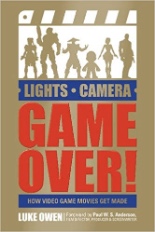
 As revenue generated from video games rivaled — and eventually eclipsed — that of motion pictures, Hollywood executives have been eager to reclaim some of those plunked quarters by adapting arcade and console favorites into movies. It wasn’t always the more-regular occurrence it is today, and the results have been messier more often than not, and both those points make Luke Owen’s book on the subject a fairly fascinating chronicle of coin-op/cinematic synergy.
As revenue generated from video games rivaled — and eventually eclipsed — that of motion pictures, Hollywood executives have been eager to reclaim some of those plunked quarters by adapting arcade and console favorites into movies. It wasn’t always the more-regular occurrence it is today, and the results have been messier more often than not, and both those points make Luke Owen’s book on the subject a fairly fascinating chronicle of coin-op/cinematic synergy.
In Schiffer Publishing’s Lights, Camera, Game Over!: How Video Game Movies Get Made, the British-based Owen offers detailed production histories of 11 key adaptations — well, okay, 10 adaptations, plus Adam Sandler’s two-bit flop on 8-bit nostalgia, 2015’s Pixels.
Whether covering the utter debacle of Super Mario Bros. or the C-cup success of Lara Croft: Tomb Raider, each chapter zeroes in on each step of the often tortured conception, development, shooting, release and (with luck) legacy of these movies, drawing upon deep-dive research and Owen’s original interviews with principal players (most notably Mortal Kombat and Resident Evil director Paul W.S. Anderson, who contributes the book’s foreword), which yields an astounding, refreshing amount of candor — such as Jean-Claude Van Damme’s drug and dong use on the set of Street Fighter.
Not every game-based flick is included (sorry, Uwe Boll fans), but Owen does not neglect to include some of the more obscure films, such as the kung-fu jiggle-fest DOA: Dead or Alive and the misbegotten Tekken, originally slated to star Jackie Chan and Jet Li. More intriguing are shorter, interstitial chapters on movies that didn’t get made, including Halo and Pac-Man — and the proposed plot for that last one (courtesy of Poltergeist rebooter Gil Kenan) is one you won’t believe!
As strong as Owen is in gaming knowledge, he is not so much in spelling. Names are botched throughout the book — not just once, in a forgivable typo, but multiple times, like “Steven Segal” every time Steven Seagal is mentioned. Legendary Paramount Pictures exec Sherry Lansing becomes “Lancy”; The Shield creator Shawn Ryan, “Rowe”; splatter director Lucio Fulci, “Fulchi”; Resident Evil franchise players James Purefoy and Iain Glen, “Purefory” and “Glenn.”
Red flags fly high even concerning the veracity of simple information, when Owen refers to “Agatha Christie’s Strangers on a Train” when surely he meant Murder on the Orient Express, or calls the Brandon Lee vehicle Rapid Fire a made-for-TV movie, or continually confuses a work visa (lowercase) with the credit card giant Visa (uppercase). He uses “cannon” for “canon,” and “coo” for “coup.” Although not as cut-and-dry, the most eyebrow-raising stumble of all is his description of 1990 Tom Hanks as an “upcoming actor,” despite being the first or second lead in no fewer than a dozen major motion pictures by then, including such hits as Splash, Bachelor Party, Dragnet and Big, the latter earning him an Academy Award nomination for Best Actor — hardly the “relative unknown” he is painted to be.
So, yes, Lights, Camera, Game Over! is in need of a reset button on the proofreading and copyediting levels, yet I’m too much of a sucker for a well-told tale of behind-the-scenes machinations to let those factual lapses sour the overall experience. In fact, I devoured all of its 315-plus pages over the course of two nights — and I don’t even like video games! I’m up for another round, because if he won’t preserve the history of Double Dragon and Doom, Lord, who will? —Rod Lott
